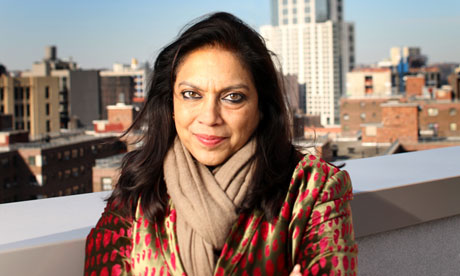
Born in Orissa, India, and educated at Delhi university and Harvard, film director Mira Nair is one of the few women to have won the Golden Lion award at Venice – for Monsoon Wedding in 2001. Nair splits her time between New York and Uganda and has founded two non-profit organisations: the Salaam Baalak Trust for street children in India, established using the proceeds from Salaam Bombay!, her 1988 debut feature; and Maisha, an educational centre in east Africa. Her new film, The Reluctant Fundamentalist, is an adaptation of Mohsin Hamid's novel and is out 10 May.
Film: Amour
I look out for anything by Michael Haneke. The worlds he creates are taut and mysterious, and in this case, full of unspoken love. I love the austerity and the love in Amour, and of course the performances. I was really taken in by it, as I was with his gorgeous black and white film, The White Ribbon, about an Austrian village. He listens to his own drum and is so unhurried, it's just beautiful.
Music: Fareed Ayaz and Abu Muhammad – Kangna
We chose to start The Reluctant Fundamentalist with this song. It's a full eight minutes of live singing! It's a traditional song, but sung anew by a family. This sound totally inspires me and is what I paid homage to in the movie. I am sustained and nourished by this sound – in fact, I'm obsessed with the modern sound coming from Pakistan these days, where ancient qawwali singing is embedded in rock and modern foundations. This tradition that we've heard for generations is now made in a way that means the young are listening. It's a programme unfortunately titled Coke Studio, which records and puts out these modern versions of traditional singing to the people. It's hugely popular, mostly within the country, but thanks to music being music we are all nourished by it across the world. It's a fantastic modern sound from Pakistan.
Design: Geoffrey Bawa
I'm a self-taught landscape gardener; it's a real passion of mine. It's what I do in my spare time, because trees don't ask questions! I've just finished planting on the Nile in Uganda where we have some land; it's a wonderful non-filmic universe. One of my heroes in landscape design is Geoffrey Bawa, a Sri Lankan architect who died a few years ago. He was very influential in south Asian design and architecture. Beyond Bawa by David Robson shows the influence of his design in architecture and landscape in the world now. It's fantastic. I've been devouring it and learning from Bawa.
Photography: Sooni Taraporevala
I'm hugely fuelled by photography in my film work. I just saw a monumental show about Parsis, the Persian Zoroastrian community in India, at one of the oldest and most radical galleries in Mumbai, the Chemould Gallery, by my dear friend Sooni. She's a screenwriter and a remarkable photographer who's shot her community over 25 years. I was dazzled by the exhibition – the humanity of it, and the unsung, unseen, but great beauty of it. This was the first time I'd seen her work occupying a huge space. It really knocked me out. Hopefully the show will travel so more people get to see it.
Book: How to Get Filthy Rich in Rising Asia by Mohsin Hamid
It sounds like a self-help book but it's actually an extraordinarily moving novel about the cycle of life and death in an unnamed country (which, for me, is clearly Pakistan). It's about living with generations and the stages of life a young man goes through to finally understand what is important.
Theatre: The Book of Mormon
I found this hilarious; it really is clever. In Uganda I am surrounded, unfortunately, by evangelicals; I can't bear it. Every night I hear the chants of Baptists urging people to be born again. Then along comes The Book of Mormon, which is not, for once, mired in political correctness, but has the intelligence to be subversive and understand that the so-called native is often cleverer than the person who has come to "show him the way". I saw it twice in New York; I think it's just fantastic. I'm in the midst of taking Monsoon Wedding to Broadway as a musical, so this was a great shot in the arm for that – showing that you can hold your voice and still make it on Broadway.

